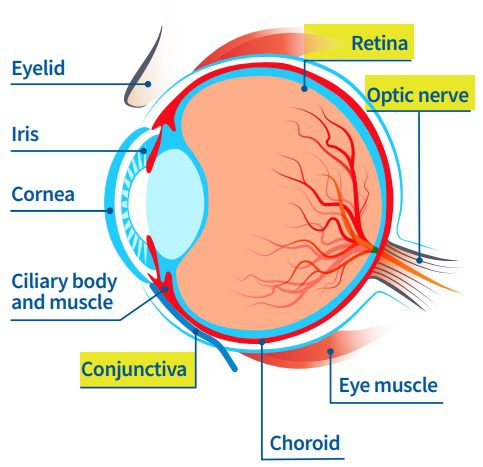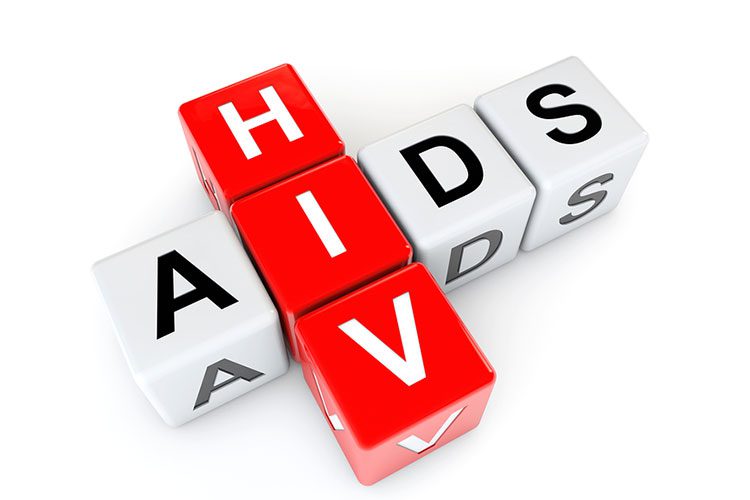HIV and the Eye
People with HIV can have problems in and around the eye that people without HIV do not get. About 70% of individuals with HIV will have an eye problem.
Download the HIV/AIDS Fact Sheet
What is HIV?
HIV (human immunodeficiency virus) is the virus that can cause AIDS (acquired immunodeficiency syndrome) if HIV is not properly treated. HIV attacks the body’s immune system, which helps fight off infections. Over time, HIV weakens the body’s ability to fight off serious infections (opportunistic infections) and some cancers. When this happens, HIV infection becomes AIDS, the advanced stage of the disease. Unlike some other viruses, the human body can’t get rid of HIV completely, even with treatment. So once a person gets HIV, they have it for life. With proper medical care, HIV can be controlled. An estimated 37.7 million people worldwide are living with HIV according to the World Health Organization. The Centers for Disease Control and Prevention (CDC) estimates that there are 1.2 million people in the United States with HIV and one in eight who are not aware they are infected.
How does HIV affect the eye?
People with HIV can have problems in and around the eye that people without HIV do not get. About 70% of individuals with HIV will have an eye problem. Sometimes these problems can be the first sign that a person has an HIV infection. Those with very weak immune systems are at risk for serious eye diseases that may lead to blindness if not identified and treated promptly.
What are some common eye conditions that can occur with HIV?
HIV retinopathy: HIV retinopathy is the most common eye problem in people with HIV. This is a problem with the blood vessels in the retina, the lining at the back of the eye that senses light coming into the eye. The retina has tiny blood vessels that can get blocked or bleed which causes damage. Small hemorrhages (bleeding) and cotton wool spots (white spots that appear on the retina because of blocked blood vessels) are seen in the retina.
Cytomegalovirus (CMV) retinitis [sai·tow·meh·guh·low·vai·ruhs reh·tuh·nai·tuhs]: CMV retinitis is the most commonly occurring opportunistic infection inside the eye of individuals living with HIV, and occurs in 20-30% of individuals with AIDS (acquired immunodeficiency syndrome). Opportunistic infections are infections that occur more often and are more severe in people with weakened immune systems. CMV infects the retina when HIV has weakened the immune system of an infected person. It often occurs in individuals with advanced stages of AIDS. Without proper treatment, CMV retinitis can destroy the retina, optic nerve, and cause retinal detachment (the retina pulls away from the back of the eye). This results in blindness.
Kaposi’s sarcoma [kuh-poh-seez sarcoma]: Kaposi’s sarcoma is a rare tumor that occurs in the eyes of patients with HIV. It is a red or purple mass that forms on the white part of the eye or on the eyelid. Kaposi’s sarcoma can also appear on other places of the body, most commonly on the skin or mouth.
Herpes zoster ophthalmicus (HZO) [her·pes zoster oph·thalmi·cus]: HZO is a common infection caused by reactivation of the chickenpox virus. It can occur in older adults (60+) or in younger people who are living with HIV. HZO can occur anywhere in the body, most commonly on the face and eyes. HZO causes a blistering and crusty rash to defined areas of the body. It can damage the eyes, causing pain and loss of vision. Squamous cell carcinoma of conjunctiva: Squamous cell carcinoma of conjunctiva is a cancer on the surface of the eye. It is more commonly seen in people with HIV/AIDS infection.
Other eye problems more common in people with HIV/ AIDS: These include dry eye, syphilis, herpes virus, gonorrhea, chlamydia, toxoplasmosis, candida, pneumocystis, and microsporidia.
Parts of the eye

What are the symptoms of HIV-related vision problems?
A person with HIV-related eye conditions may not have any noticeable change in vision, or have outward symptoms, but permanent damage to the eye can be occurring. Individuals should see an eye doctor if changes in vision or the appearance of the eye occurs. Keep a lookout for the following changes:
- Blurry or decreased vision
- Double vision
- Changes in color vision
- Seeing spots
- Loss of peripheral (side) vision
- Floaters
- Flashing lights
- Eye pain
- Sensitivity to light
- Watery eyes
How are HIV-related vision problems diagnosed?
A person with HIV should have yearly comprehensive eye exams with an eye doctor. Because of increased risk of eye problems, people with compromised immune systems may need to see an eye doctor more often, like every three months.
During a comprehensive eye exam, the eye doctor will conduct the following tests, among others:
- Visual acuity: This test will find out how well you can see through your central vision in each eye. This is the part of the exam when you read an eye chart to see how clearly you see.
- Dilated eye examination: The eye doctor will dilate (widen) the pupils of the eyes with eye drops to allow a better view of the back of your eyes (retina and macula). The doctor will look for changes in the retina and macula.
How are HIV-related eye diseases treated?
Treatment for HIV-related eye problems depends on the specific vision problem.
- Medicines can help treat infections
- Tumors may be treated with radiation or surgery
- Retina damaged by bleeding and swelling inside the eye may need eye injections, surgery or laser treatment
Individuals should discuss their treatment options with their eye care provider, and seek out the treatment that will meet their personal and lifestyle needs. A person with HIV who maintains a healthy immune system by taking antiviral drug treatments as recommended are at lower risk of developing HIV-related eye diseases.
